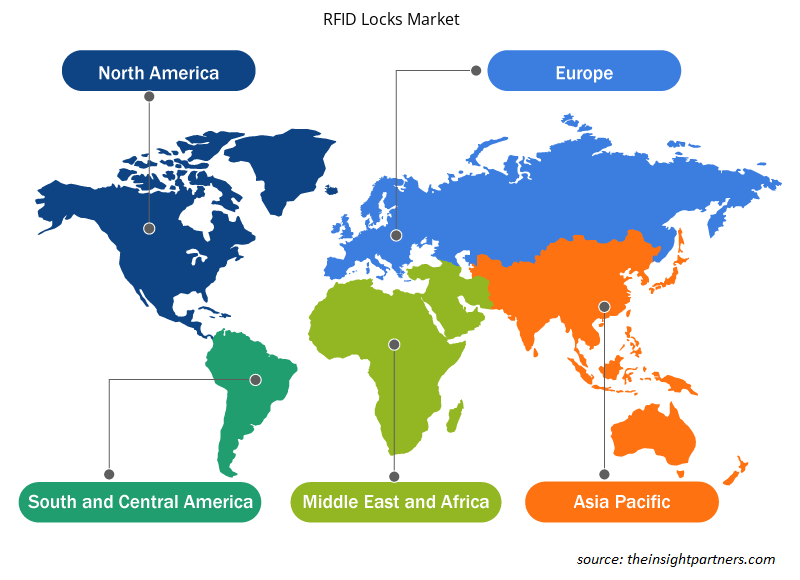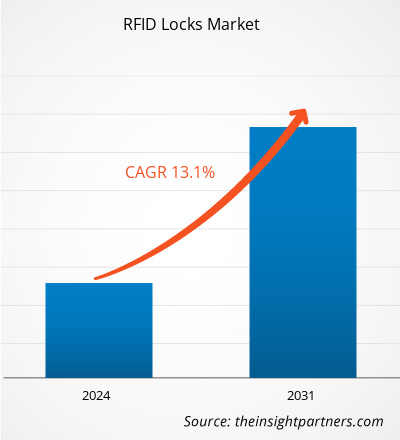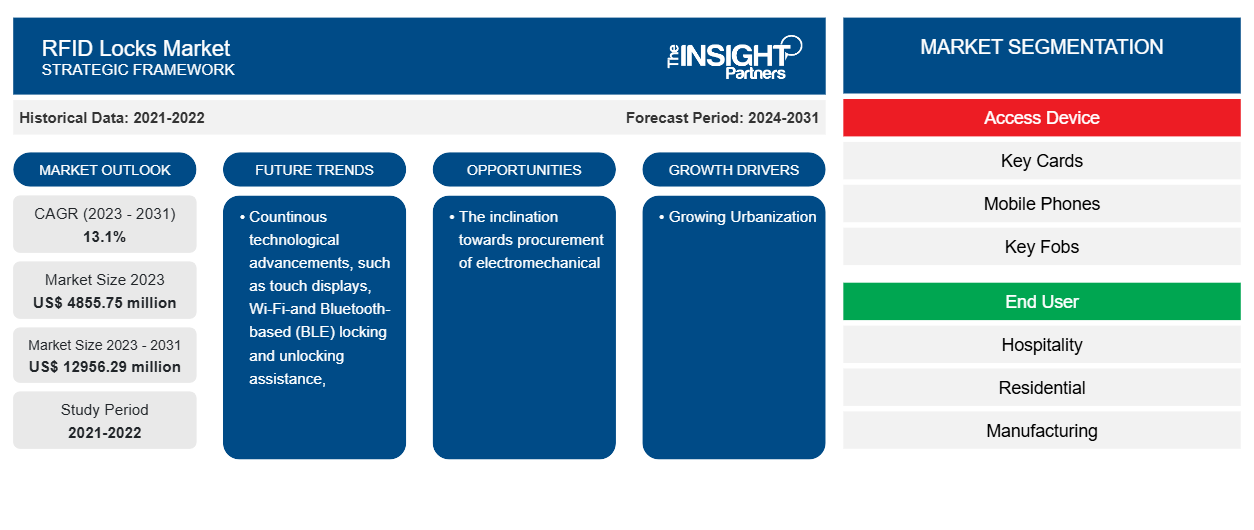Der Markt für RFID-Schlösser soll von 4855,75 Millionen US-Dollar im Jahr 2023 auf 12956,29 Millionen US-Dollar im Jahr 2031 anwachsen. Der Markt soll zwischen 2023 und 2031 eine durchschnittliche jährliche Wachstumsrate (CAGR) von 13,1 % verzeichnen. Kontinuierliche technologische Fortschritte wie Touch-Displays, Wi-Fi- und Bluetooth-basierte (BLE) Verriegelungen und Entriegelungshilfen werden wahrscheinlich weiterhin ein Schlüsselsystem zur Erkennung von Markttrends bleiben.
RFID-Schlösser Marktanalyse
Verschiedene Faktoren, insbesondere die Expansion der Hotel- und Tourismusbranche weltweit, treiben den Bau neuer Gewerbegebäude, darunter auch Hotels, voran. Die Expansion von REID-Schlössern wird direkt durch Pläne zum Bau von Hotels mit mehr Zimmern und eine Erhöhung der staatlichen Finanzierung zur Unterstützung der Hotelbranche vorangetrieben, was die Expansion des Marktes fördert. Einer der Hauptfaktoren, die die Nachfrage nach verbesserten Zugangslösungen antreiben, ist die Urbanisierung. Der Bedarf an immer komplexeren und fortschrittlicheren Infrastrukturlösungen wächst, da durch die Urbanisierung mehr Ballungsräume und Städte mit einer Million oder mehr Einwohnern entstehen. Dieser Faktor trägt ebenfalls erheblich zur Expansion des Marktes bei.
RFID-Übersicht
Ein elektronisches Schloss, das eine Funkkarte als Schlüssel verwendet, wird RFID-Schloss oder Identifikationskartenschloss genannt. Die altmodische kontaktierbare Karte benötigte physischen Kontakt mit einem Lesegerät, um ein Schloss zu öffnen; mit der RFID-Technologie kann die RFID-Karte dies kontaktlos tun. Die RFID-Technologie verwendet elektromagnetische Wellen, um Signale als Teil ihres Erkennungssystems zu übermitteln. Aufgrund seines traditionellen Konzepts und seiner hohen Kosten wird das RFID-Schließsystem außerdem nicht verwendet, um mechanische Schlösser für den Hausgebrauch zu ersetzen. Darüber hinaus kann die Echtzeitleistung von RFID-Türschlössern entweder erfolgreich oder nicht erfolgreich sein.
Passen Sie diesen Bericht Ihren Anforderungen an
Sie erhalten kostenlos individuelle Anpassungen an jedem Bericht, einschließlich Teilen dieses Berichts oder einer Analyse auf Länderebene, eines Excel-Datenpakets sowie tolle Angebote und Rabatte für Start-ups und Universitäten.
-
Holen Sie sich die wichtigsten Markttrends aus diesem Bericht.Dieses KOSTENLOSE Beispiel umfasst eine Datenanalyse von Markttrends bis hin zu Schätzungen und Prognosen.
Treiber und Chancen von RFID
Zunehmende Urbanisierung
Das globale Bevölkerungswachstum und die zunehmende Migration vom Land in die Stadt treiben den Aufwärtstrend bei der Urbanisierung voran. In weniger entwickelten Ländern wächst die städtische Bevölkerung langsamer als in hoch entwickelten Ländern. Menschen, die auf der Suche nach neuen Arbeitsplätzen, Wohnungen und Ladenflächen umziehen, machen Zutrittskontrollen und Sicherheitssysteme in Gebäuden erforderlich, um ungebetene Besucher fernzuhalten. Immer mehr Wohnhäuser, Büros, Hotels, Lagerhallen und andere Orte verwenden intelligente Schließsysteme. Da es nicht mehr nötig ist, einen Schlüssel mit sich zu tragen oder sich ein Passwort zu merken, bietet die Entwicklung von digitalen Touchpad-Schlössern, Fingerabdruckschlössern , REID-Karten und anderen intelligenten Schlössern den Verbrauchern noch mehr Komfort. Im Wohn- und Gewerbebereich ist eindeutig ein Anstieg bei Zutrittssicherheitslösungen zu verzeichnen.
Die Tendenz zur Anschaffung elektromechanischer Produkte gegenüber herkömmlichen Schließsystemen
Die Vorliebe für elektromechanische Produkte gegenüber herkömmlichen Schließsystemen hat stark zugenommen, und dieser Trend wird sich voraussichtlich fortsetzen, was den Benutzern intelligenter Schließsysteme eine Vielzahl von Wachstumsoptionen bietet. Einige der Merkmale, die der Markt für REID-Schlösser bietet, sind ergonomisches Design, gut geeignetes Design, ADA-Konformität, Universalität und Flexibilität, was ihre Beliebtheit in Unternehmen, insbesondere Hotels, steigert. In vielen Wohnhäusern, Wohnungen, Schulen, kleinen Geschäftsgebäuden und anderen vergleichbaren Orten werden die Außen- und Innentüren immer noch mit herkömmlichen Schlüssel- und Türklinkenschlössern verschlossen. Intelligente Schließlösungen werden bei Firmeninhabern und Hausbesitzern aufgrund der zunehmenden Urbanisierung und des gestiegenen Sicherheitsbedarfs immer beliebter. Um ihre elektronischen Schlösser intelligenter zu machen, integrieren Schlosshersteller daher intelligente Technologie in sie. Daher wird erwartet, dass die Tendenz zur Beschaffung elektromechanischer Produkte gegenüber herkömmlichen Schließsystemen den RFID-Akteuren im Prognosezeitraum neue Möglichkeiten bietet.
RFID-Bericht-Segmentierungsanalyse
Wichtige Segmente, die zur Ableitung der RFID-Analyse beigetragen haben, sind Anwendung und Endbenutzer.
- Basierend auf dem Zugangsgerät wird RFID in Schlüsselkarten, Mobiltelefone und Schlüsselanhänger unterteilt. Das Segment Schlüsselkarten hatte im Jahr 2023 einen größeren Marktanteil
Basierend auf dem Endbenutzer wird RFID in die Bereiche Gastgewerbe, Wohnen, Fertigung, Einzelhandel, Automobil, Luft- und Raumfahrt & Verteidigung, Regierung & öffentliche Versorgung und andere unterteilt.
RFID-Anteilsanalyse nach Geografie
Der geografische Umfang des RFID-Berichts ist hauptsächlich in fünf Regionen unterteilt: Nordamerika, Asien-Pazifik, Europa, Naher Osten und Afrika sowie Südamerika/Süd- und Mittelamerika. Fortschrittliche Sicherheitstechnologien wie RFID- und NFC-fähige Türschlösser werden in der Region APAC immer bekannter, insbesondere für Sicherheitsanwendungen im Privatbereich. Darüber hinaus investieren große Unternehmen in Entwicklungsländer wie China und Japan, was den Bedarf an erschwinglichen Lösungen für eine effektive Zugangskontrolle steigert . Während des gesamten Prognosezeitraums wird erwartet, dass der Markt der Region APAC aufgrund dieser Investitionen und der zunehmenden Nutzung fortschrittlicher Sicherheitslösungen wachsen wird.
Umfang des RFID-Berichts
RFID-Neuigkeiten und aktuelle Entwicklungen
Die RFID-Evaluierung erfolgt durch die Erhebung qualitativer und quantitativer Daten nach Primär- und Sekundärforschung, die wichtige Unternehmenspublikationen, Verbandsdaten und Datenbanken umfasst. Im Folgenden finden Sie eine Liste der Entwicklungen auf dem Markt für Sprach- und Sprechstörungen sowie Strategien:
- Im August 2022 führte Kalahari Resorts & Conventions die RFID-Türschlosstechnologie und das Zugangskontrollmanagementsystem Visionline von Assa Abloy Global Solutions ein. Mit nur einem RFID-Armband oder einer Schlüsselkarte können Gäste ihr Zimmer betreten, andere Resorts nutzen und Artikel kaufen, ohne persönliche Kreditkarten oder Bargeld mit sich führen zu müssen.
(Quelle: Kalahari Resorts & Conventions, Pressemitteilung)
- Im September 2021 erwarb Honeywell das in Privatbesitz befindliche Unternehmen Performix Inc. Die Übernahme basiert auf der Strategie von Honeywell, die weltweit führende integrierte Softwareplattform für Kunden in der Biowissenschaftsbranche zu schaffen, die eine schnellere Einhaltung von Vorschriften, höhere Zuverlässigkeit und ein höheres Produktionsvolumen anstreben.
(Quelle: Honeywell, Pressemitteilung)
Regionale Einblicke in den RFID-Schlössermarkt
Die regionalen Trends und Faktoren, die den Markt für RFID-Schlösser im Prognosezeitraum beeinflussen, wurden von den Analysten von Insight Partners ausführlich erläutert. In diesem Abschnitt werden auch die Marktsegmente und die Geografie für RFID-Schlösser in Nordamerika, Europa, im asiatisch-pazifischen Raum, im Nahen Osten und Afrika sowie in Süd- und Mittelamerika erörtert.

- Holen Sie sich die regionalen Daten für den RFID-Schlössermarkt
Umfang des Marktberichts zu RFID-Schlössern
| Berichtsattribut | Details |
|---|---|
| Marktgröße im Jahr 2023 | 4855,75 Millionen US-Dollar |
| Marktgröße bis 2031 | 12956,29 Millionen US-Dollar |
| Globale CAGR (2023 - 2031) | 13,1 % |
| Historische Daten | 2021-2022 |
| Prognosezeitraum | 2024–2031 |
| Abgedeckte Segmente |
Nach Zugriffsgerät
|
| Abgedeckte Regionen und Länder |
Nordamerika
|
| Marktführer und wichtige Unternehmensprofile |
|
Dichte der Marktteilnehmer für RFID-Schlösser: Auswirkungen auf die Geschäftsdynamik verstehen
Der Markt für RFID-Schlösser wächst rasant, angetrieben durch die steigende Nachfrage der Endnutzer aufgrund von Faktoren wie sich entwickelnden Verbraucherpräferenzen, technologischen Fortschritten und einem größeren Bewusstsein für die Vorteile des Produkts. Mit steigender Nachfrage erweitern Unternehmen ihr Angebot, entwickeln Innovationen, um die Bedürfnisse der Verbraucher zu erfüllen, und nutzen neue Trends, was das Marktwachstum weiter ankurbelt.
Die Marktteilnehmerdichte bezieht sich auf die Verteilung der Firmen oder Unternehmen, die in einem bestimmten Markt oder einer bestimmten Branche tätig sind. Sie gibt an, wie viele Wettbewerber (Marktteilnehmer) in einem bestimmten Marktraum im Verhältnis zu seiner Größe oder seinem gesamten Marktwert präsent sind.
Die wichtigsten auf dem Markt für RFID-Schlösser tätigen Unternehmen sind:
- Assa Abloy AB
- Bai Fu Co. Ltd
- Digilock (Sicherheitsleute Inc.)
- Dormakaba Gruppe
- Euro-locks SA NV (Lowe and Fletcher Group)
- Godrej und Boyce Manufacturing Company Ltd.
Haftungsausschluss : Die oben aufgeführten Unternehmen sind nicht in einer bestimmten Reihenfolge aufgeführt.

- Überblick über die wichtigsten Akteure auf dem RFID-Schlössermarkt
Marktbericht zu RFID-Schlössern – Umfang und Ergebnisse
Der Bericht „Marktgröße und Prognose für RFID-Schlösser (2021–2031)“ bietet eine detaillierte Analyse des Marktes, die die folgenden Bereiche abdeckt:
- Marktgröße und Prognose auf globaler, regionaler und Länderebene für alle wichtigen Marktsegmente, die im Rahmen des Projekts abgedeckt sind
- Marktdynamik wie Treiber, Beschränkungen und wichtige Chancen
- Wichtige Zukunftstrends
- Detaillierte PEST/Porters Five Forces- und SWOT-Analyse
- Globale und regionale Marktanalyse mit wichtigen Markttrends, wichtigen Akteuren, Vorschriften und aktuellen Marktentwicklungen
- Branchenlandschaft und Wettbewerbsanalyse, einschließlich Marktkonzentration, Heatmap-Analyse, prominenten Akteuren und aktuellen Entwicklungen
- Detaillierte Firmenprofile
- Historische Analyse (2 Jahre), Basisjahr, Prognose (7 Jahre) mit CAGR
- PEST- und SWOT-Analyse
- Marktgröße Wert/Volumen – Global, Regional, Land
- Branchen- und Wettbewerbslandschaft
- Excel-Datensatz
Aktuelle Berichte
Verwandte Berichte
Erfahrungsberichte
Grund zum Kauf
- Fundierte Entscheidungsfindung
- Marktdynamik verstehen
- Wettbewerbsanalyse
- Kundeneinblicke
- Marktprognosen
- Risikominimierung
- Strategische Planung
- Investitionsbegründung
- Identifizierung neuer Märkte
- Verbesserung von Marketingstrategien
- Steigerung der Betriebseffizienz
- Anpassung an regulatorische Trends























 Kostenlose Probe anfordern für - Markt für RFID-Schlösser
Kostenlose Probe anfordern für - Markt für RFID-Schlösser